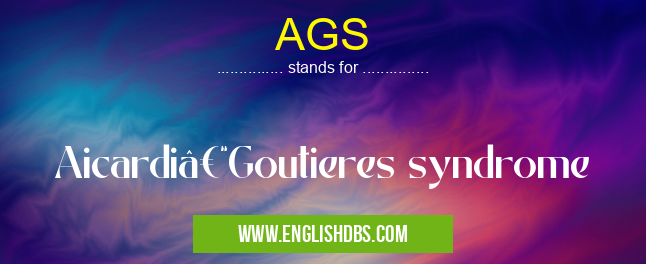What does AGS mean in SYNDROMES
Aicardi–Goutières syndrome (AGS) is a rare genetic disorder characterized by neurological complications including inflammation of the brain and spinal cord. AGS is caused by mutations in one of five different genes associated with the production of proteins involved in DNA replication, repair processes, and other critical cellular functions. It typically presents within the first few months or years of life and can cause a range of serious medical issues. People with AGS usually have intellectual disability, impaired movement control, hearing loss, vision impairment, and seizures. There is currently no cure for AGS; however, knowledge about its cause is increasing and treatments are improving slowly over time.

AGS meaning in Syndromes in Medical
AGS mostly used in an acronym Syndromes in Category Medical that means Aicardi–Goutieres syndrome
Shorthand: AGS,
Full Form: Aicardi–Goutieres syndrome
For more information of "Aicardi–Goutieres syndrome", see the section below.
Symptoms
Patients with AGS typically experience neurological complications such as increased intracranial pressure that leads to decreased head circumference (microcephaly), impaired motor control that causes difficulty with movement coordination (ataxia) and balance (dysmetria), seizures (epilepsy), cognitive impairments such as delays in learning or mental retardation, hearing deficits, vision problems such as blindness or weak eyesight (amblyopia), speech delays, behavioral changes including anxiety or acting out behaviorally, increased susceptibility to infections due to an inhibited immune system, kidney malfunctioning/failure, or failure to thrive.
Causes
The cause of Aicardi–Goutière syndrome is unknown unidentified mutations occurring de novo (sporadically) in one five related genes which lead to abnormal production of proteins involved in DNA replication repair processes and other important cell functions These include TREX1 ADAR SAMHD1 RNaseH2A RNaseH2B Cytopathic hypoxia may also play a role In most cases this abnormal production occurs without any family history.
Treatment
Although there is currently no cure for Aicardi–Goutières Syndrome treatment options exist that can help manage symptoms These include medications for controlling seizures physical therapy occupational therapy supportive care such as nutrition therapy psychological counseling vision restoration therapies speech language therapies and educational interventions Additionally gene therapy research could potentially provide hope for curing this disease.
Essential Questions and Answers on Aicardi–Goutieres syndrome in "MEDICAL»SYNDROMES"
What is Aicardi–Goutieres Syndrome (AGS)?
Aicardi–Goutières syndrome (AGS) is an extremely rare neurological disorder that presents within the first 6 months of life, characterized by encephalopathy (brain inflammation), chilblains on hands and feet, calcifications of the basal ganglia, and an increased protein level in the cerebrospinal fluid.
What are the causes of AGS?
The cause of AGS is currently unknown. It has been linked to mutations in several genes involved in DNA repair and inflammation pathways, including the TREX1, RNASEH2A, RNASEH2B, RNASEH2C, SAMHD1 and ADAR gene.
How common is AGS?
AGS is estimated to affect 1 in 100 000 infants worldwide. It has been found most commonly among individuals who have a belonging to certain ethnic groups or geographical regions.
What are the symptoms associated with AGS?
Symptoms associated with AGS include progressive neurodevelopmental delay (such as delayed motor skills development or intellectual disabilities), microcephaly (abnormally small head size), feeding and/or respiratory difficulties, poor muscle tone and physical growth delay. Other features may include seizures, chilblain lesions on fingers or toes caused by cold weather exposure, eye abnormalities such as ptosis or cataracts, joint contractures and skin rashes.
Is there treatment for AGS?
While there is no specific cure for AGS at this time, supportive care including physical therapy can help improve motor development and reduce seizures. Additionally, anti-inflammatory medications may help reduce inflammation in the brain which can improve brain function.
How is AGS diagnosed?
Diagnosis of AGS usually requires a combination of clinical evaluation and genetic testing to look for variants in known causative genes related to AGS. Imaging tests such as Magnetic Resonance Imaging (MRI) scans or Computed Tomography (CT) scans may also be used to detect any brain abnormalities associated with AGS..
Are there any complications associated with AGS?
Yes; possible complications associated with AGS include physical deformities due to bone calcification, respiratory problems due to weakened muscles along with feeding difficulties due to weak muscles around the mouth area.
Final Words:
Aicardi–Goutières Syndrome (AGS) is a rare genetic disorder characterized by severe neurological complications that affect multiple body systems and can cause lifethreatening medical problems Despite lacking a cure treatments exist to help manage symptoms such as Speech Language Therapy Physical Therapy Occupational Therapy Counseling Vision Restoration Therapies Seizure Medication Nutritional Support Educational Interventions as well as Gene Therapy Research being conducted to potentially provide a longerterm solution
AGS also stands for: |
|
| All stands for AGS |
